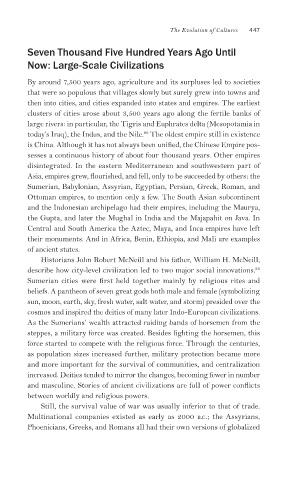Page 482 - Cultures and Organizations
P. 482
The Evolution of Cultures 447
Seven Thousand Five Hundred Years Ago Until
Now: Large-Scale Civilizations
By around 7,500 years ago, agriculture and its surpluses led to societies
that were so populous that villages slowly but surely grew into towns and
then into cities, and cities expanded into states and empires. The earliest
clusters of cities arose about 3,500 years ago along the fertile banks of
large rivers: in particular, the Tigris and Euphrates delta (Mesopotamia in
22
today’s Iraq), the Indus, and the Nile. The oldest empire still in existence
is China. Although it has not always been unified, the Chinese Empire pos-
sesses a continuous history of about four thousand years. Other empires
disintegrated. In the eastern Mediterranean and southwestern part of
Asia, empires grew, flourished, and fell, only to be succeeded by others: the
Sumerian, Babylonian, Assyrian, Egyptian, Persian, Greek, Roman, and
Ottoman empires, to mention only a few. The South Asian subcontinent
and the Indonesian archipelago had their empires, including the Maurya,
the Gupta, and later the Mughal in India and the Majapahit on Java. In
Central and South America the Aztec, Maya, and Inca empires have left
their monuments. And in Africa, Benin, Ethiopia, and Mali are examples
of ancient states.
Historians John Robert McNeill and his father, William H. McNeill,
describe how city-level civilization led to two major social innovations. 23
Sumerian cities were first held together mainly by religious rites and
beliefs. A pantheon of seven great gods both male and female (symbolizing
sun, moon, earth, sky, fresh water, salt water, and storm) presided over the
cosmos and inspired the deities of many later Indo-European civilizations.
As the Sumerians’ wealth attracted raiding bands of horsemen from the
steppes, a military force was created. Besides fighting the horsemen, this
force started to compete with the religious force. Through the centuries,
as population sizes increased further, military protection became more
and more important for the survival of communities, and centralization
increased. Deities tended to mirror the changes, becoming fewer in number
and masculine. Stories of ancient civilizations are full of power confl icts
between worldly and religious powers.
Still, the survival value of war was usually inferior to that of trade.
Multinational companies existed as early as 2000 b.c.; the Assyrians,
Phoenicians, Greeks, and Romans all had their own versions of globalized

